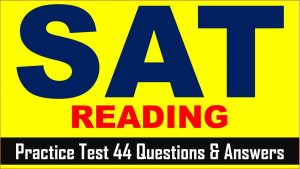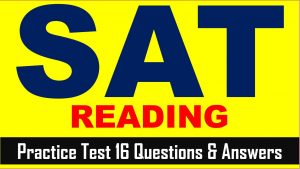Hi SAT Aspirants, welcome to AKVTutorials. As you know SAT (Scholastic Assessment Test) is a standard test, used for taking admission to undergraduate programs of universities or colleges of United States. SAT is developed and published by the College Board, an organization in United States, administered by the Educational Testing Service. Are you searching for SAT Reading Practice Questions? Then, in this article of AKVTutorials, you will get SAT Reading Prep Test 66 | SAT Practice Reading Passage Test 66 | SAT 2024 Online Tutor AMBiPi
SAT Reading Practice Passage
SAT Reading Practice Test Comprehensive Passage
This passage is adapted from Steven Johnson’s article on learning adaptation. The New York Times Sunday Magazines. The following 10 multiple choice questions are based on this passage below.
| On Jan. 24, the Fox network showed an episode of its hit | |
| drama “24,” the real-time thriller known for its cliffhanger | |
| tension and often-gruesome violence, Over the preceding | |
| weeks, a number of public controversies had erupted around | |
| Line 5 | “24,” mostly focused on its portrait of Muslim terrorists |
| and its penchant for torture scenes. The episode that was shown | |
| on the 24th only fanned the flames higher: in one scene, a | |
| terrorist enlists a hit man to kill his child for not fully | |
| supporting the jihadist cause; in another scene, the secretary | |
| Line 10 | of defense authorizes the torture of his son to uncover |
| evidence of a terrorist plot. | |
| But the explicit violence and the post-9/11 terrorist anxiety | |
| are not the only elements of “24” that would have been | |
| unthinkable on prime-time network television 20 years ago. | |
| Line 15 | Alongside the notable change in content lies an equally |
| notable change in form. During its 44 minutes —a real-time | |
| hour, minus 16 minutes for commercials — the episode | |
| connects the lives of 21 distinct characters, each with a | |
| clearly defined “story arc,” as the Hollywood jargon has it: a | |
| Line 20 | defined personality with motivations and obstacles and |
| specific relationships with other characters, Nine primary | |
| narrative threads wind their way through those 44 minutes, | |
| each drawing extensively upon events and information | |
| revealed in earlier episodes. Draw a map of all those | |
| Line 25 | intersecting plots and personalities, and you get structure that |
| — where formal complexity is concerned — more closely | |
| resembles “Middlemarch” than a hit TV drama of years past | |
| like “Bonanza.” | |
| For decades, we’ve worked under the assumption that mass | |
| Line 30 | culture follows a path declining steadily toward |
| lowest-common-denominator standards, presumably because | |
| the “masses” want dumb, simple pleasures and big media | |
| companies try to give the masses what they want. But as that | |
| “24” episode suggests, the exact opposite is happening: the | |
| Line 35 | culture is getting more cognitively demanding, not less. To |
| make sense of an episode of “24,” you have to integrate far | |
| more information than you would have a few decades ago | |
| watching a comparable show. Beneath the violence and the | |
| ethnic stereotypes, another trend appears: to keep up with | |
| Line 40 | entertainment like “24,” you have to pay attention, make |
| inferences, track shifting social relationships. This is what I | |
| call the Sleeper Curve: the most debased forms of mass | |
| diversion —video games and violent television dramas and | |
| juvenile sitcoms — turn out to be nutritional after all. | |
| Line 45 | I believe that the Sleeper Curve is the single most important |
| new force altering the mental development of young people | |
|
today, and I believe it is largely a force for good: enhancing
|
|
| our cognitive faculties, not dumbing them down. and yet you | |
| almost never hear this story in popular accounts of today’s | |
| Line 50 | media. Instead, you hear dire tales of addiction, violence, |
| mindless escapism, It’s assumed that shows that promote | |
| smoking or gratuitous violence are bad for us, while those | |
| that thunder against teen pregnancy or intolerance have a | |
| positive role in society. Judged by that morality-play | |
| Line 55 | standard, the story of popular culture over the past 50 years — |
| if not 500 —is a story of decline; the morals of the stories | |
| have grown darker and more ambiguous, and the antiheroes | |
| have multiplied. | |
| The usual counterargument here is that what media have lost | |
| Line 60 | in moral clarity, they have gained in realism. The real world |
| doesn’t come in nicely packaged public-service | |
| announcements, and we’re better off with entertainment like | |
| “The Sopranos” that reflects our fallen state with all its | |
| ethical ambiguity. I happen to be sympathetic to that | |
| Line 65 | argument, but it’s not the one I want to make here, I think |
| there is another way to assess the social virtue of pop culture, | |
| one that looks at media as a kind of cognitive workout, not as | |
| a series of life lessons. There may indeed be more “negative | |
| messages” in the mediasphere today. But that’s not the only | |
| Line 70 | way to evaluate whether our television shows or video games |
| are having a positive impact. Just as important — if not more | |
| important —is the kind of thinking you have to do to make | |
| sense of a cultural experience. That is where the Sleeper | |
| Curve becomes visible. |
SAT Reading Comprehension Practice Test Questions
SAT Reading Practice Test Question No 1
Which choice best summarizes the article as a whole?
Option A : It counters some widely held beliefs while offering creditable explanations.
Option B : It provides a series of evidences to reinforce an argument made earlier.
Option C : It proposes a concept that is useful in evaluating cultural experiences,
Option D : It describes the source and development of certain trend in media.
SAT Practice Test Answer No 1
Show/Hide Answer
Option A : It counters some widely held beliefs while offering creditable explanations.
SAT Reading Practice Test Question No 2
The hit drama “24” in the article can be understood as
Option A : a prime time TV program that allures many.
Option B : a cultural symbol that holds real public sway.
Option C : a paragon that embodies intricacy and inference.
Option D : a byproduct of mass illusion and ethnic stereotype.
SAT Practice Test Answer No 2
Show/Hide Answer
Option C : a paragon that embodies intricacy and inference.
SAT Reading Practice Test Question No 3
Which choice provides the best evidence to support the answer to the previous question?
Option A : Lines 1-6 (“On…scenes”)
Option B : Lines 12-16 (“But…form”)
Option C : Lines 16-21 (“During…characters”)
Option D : Lines 29-33 (“For…want”)
SAT Practice Test Answer No 3
Show/Hide Answer
Option C : Lines 16-21 (“During…characters”)
SAT Reading Practice Test Question No 4
What can be reasonably inferred from author’s discussion of “the prime-time network television 20 years ago” in line 14?
Option A : It didn’t display such intense complexities in plots and characters.
Option B : It didn’t display such intense complexities in plots and characters.
Option C : Many other elements were involved in the TV programs 20 years ago.
Option D : The characters in network programs were more like those in propaganda.
SAT Practice Test Answer No 4
Show/Hide Answer
Option A : It didn’t display such intense complexities in plots and characters.
SAT Reading Practice Test Question No 5
As used in the passage, the word “ jargon” in line 19 most nearly means
Option A : calling.
Option B : specialty.
Option C : terminology.
Option D : particularity.
SAT Practice Test Answer No 5
Show/Hide Answer
Option C : terminology.
SAT Reading Practice Test Question No 6
Which choice best characterizes the two works “Middlemarch” and “Bonanza,” respectively?
Option A : The former is an intriguing story while the latter is a trite play with no attraction at all,
Option B : The former is setting on highly convoluted story-lines while the latter is more about one single scene
Option C : The former is a moralistic story with lessons abound in its lines while the latter is the exact opposite.
Option D : The former is a product of modern television technology while the latter is more adapted from the old formats.
SAT Practice Test Answer No 6
Show/Hide Answer
Option B : The former is setting on highly convoluted story-lines while the latter is more about one single scene
SAT Reading Practice Test Question No 7
The author suggests the public now has become “cognitively demanding” because
Option A : the old assumption regarding public consensus no longer holds any truth to the media,
Option B : shows like the “Middlemarch” are simply too complex to be realistic in the more pragmatic public eyes.
Option C : they have to maneuver through a maze of plots and relations to understand shows like the “24”.
Option D : the Sleeper Curve has to come into the consideration of the discussion of public cognition and senses,
SAT Practice Test Answer No 7
Show/Hide Answer
Option C : they have to maneuver through a maze of plots and relations to understand shows like the “24”.
SAT Reading Practice Test Question No 8
Which choice provides the best evidence to support the answer to the previous question?
Option A : Lines 24-28 (“Draw…Bonanza”)
Option B : Lines 29-33 (“For…want”)
Option C : Lines 38-41 (“Beneath… relationships”)
Option D : Lines 41-44 (“This…all”)
SAT Practice Test Answer No 8
Show/Hide Answer
Option B : Lines 38-41 (“Beneath… relationships”)
SAT Reading Practice Test Question No 9
The word “debased” in line 42 most nearly means
Option A : undermined.
Option B : devastated.
Option C : compromised.
Option D : trivialized.
SAT Practice Test Answer No 9
Show/Hide Answer
Option D : trivialized.
SAT Reading Practice Test Question No 10
The author employs which of the following in introducing the concept of Sleeper Curve?
Option A : Metaphors.
Option B : Analogies.
Option C : Humors,
Option D : Assertion.
SAT Practice Test Answer No 10
Show/Hide Answer
Option D : Assertion.
SAT Reading Practice Test Question No 11
Which choice best indicates the tone of the author when he proposes the Sleeeper Curve as a new way of understanding in line 45?
Option A : Personalized examples.
Option B : Affirmed conviction.
Option C : Baseless charges.
Option D : Hypothetical ideals.
SAT Practice Test Answer No 11
Show/Hide Answer
Option B : Affirmed conviction.
SAT Reading Practice Test Question No 12
According to the “morality-play standard” in lines 54-55, what can reasonably be inferred about the story of popular culture over the past 50 years?
Option A : They are examples of failures in social changes.
Option B : Violence is more vehemently condemned in these stories and programs.
Option C : Objections to juvenile delinquent behaviors become less and less frequent.
Option D : Arguments for abortion rights win more supports through all these stories.
SAT Practice Test Answer No 12
Show/Hide Answer
Option C : Objections to juvenile delinquent behaviors become less and less frequent.
SAT Reading Practice Test Question No 13
In the last paragraph, the author is primarily concerned with
Option A : highlighting the importance of viewing culture experience not merely as a series of moral lessons.
Option B : proposing a new way to access the public mentality and cognitive process.
Option C : identifying the best approach to understand the decline of social morals.
Option D : Recognizing the challenges ahead for media professionals in learning about the viewing audience’s demands.
SAT Practice Test Answer No 13
Show/Hide Answer
Option A : highlighting the importance of viewing culture experience not merely as a series of moral lessons.



